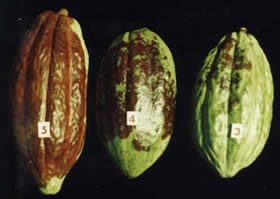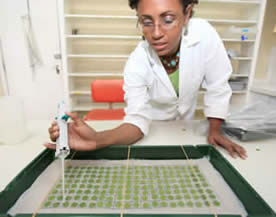BP Resistance Enhancement
Germplasm Enhancement for Black Pod disease resistance
Cacao accessions with a wide genetic base and useful traits are selected for inclusion in a germplasm enhancement programme. Crosses are made by controlled pollination of parents and seedling progeny are raised in a greenhouse for evaluation.
The priority trait in the current programme is resistance to Black Pod disease, this being the most widespread fungal disease of cacao worldwide. Accessions in the ICG,T are being systematically evaluated for Black Pod resistance using a detached pod inoculation method.

Seedlings are evaluated for Black Pod at an early stage using a leaf disc inoculation method and, by grafting the parental clones onto rootstocks, tests on young leaves from the parents can be compared with those from the progeny.

Segregation in the progeny provides the possibility of selecting seedlings with more resistance to Black Pod than the parents.
The programme aims to accumulate genes for Black Pod resistance in populations with a wide genetic base. These will be distributed, via intermediate quarantine, to cocoa producing countries for inclusion in local breeding programmes.
More CFC Projects
Cocoa Productivity | BP Resistance Screening |
CFC Project Collection | Flavour Project

















